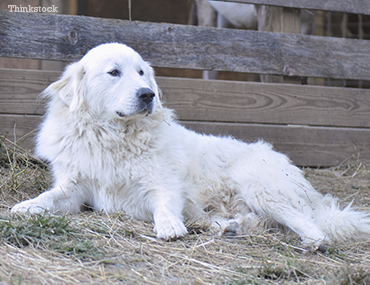Background:
The Great Pyrenees most likely traveled from Central Asia with the Aryans and Phoenician traders. They settled with the peasants in the Pyrenees mountain regions. They could be descendant from the ancient Tibetan Mastiffs and might have in turn contributed to the Newfoundland line. This large breed was initially used to guard flocks, they were naturally nocturnal and their white fur allowed them to blend in with the sheep and surprise would-be attackers. The dogs also wore spiked collars to protect their throats from predators.
Although they started out as dogs for the everyman, Pyrenees caught the attention of nobility during the 1600s. Louis XIV was especially fond of them. Packs of Pyrenees were also used to guard chateaus at that time.
The Great Pyrenees dogs became famous for their bravery and were first imported into America during the 1800s. Unfortunately these specimens were a far cry from those that existed in the mountains of France. The Pyrenees failed to gain American Kennel Club recognition until 1933. Fortunately, stronger imports have followed and the breed has achieved moderate popularity.
Sizing up:
- Weight: 85 to 115 lbs.
- Height: 25 to 32 inches
- Coat: Thick double coat
- Color: White
- Life expectancy: 10 to 12 years
What’s the Great Pyrenees like?
The Great Pyrenees is a devoted and trustworthy guardian, be it with his flock or with his family. In many parts of the country the Pyrenees is still used to keep vigil over the herd. With his family the Pyrenees will be loving and grateful for every moment. He’s great with kids but his size can be a concern so supervision is important.
The Pyrenees doesn’t do well in hot weather conditions and for the most part would rather spend his time indoors with the family. Daily exercise is a requirement but a brisk walk should be enough to satisfy the Pyrenees.
The Great Pyrenees is mistrustful of strangers, as a watchdog he’s also likely to bark at night. It’s important that both of these traits be addressed early during training. Socialize him often and dissuade him from barking. The Pyrenees can be difficult to train so patience is one of your most important tools. Considering the size of the Great Pyrenees it’s essential that you teach him not to pull on the leash. It’s also important that you supervise him during adolescence to prevent any household chewing.
The Pyrenees has extra tolerance for cold weather and would be a good companion for cross country skiing. Keep him on a leash though, or he might wander off and get into trouble.
The Pyrenees’ thick double coat requires approximately thirty minutes of weekly brushing.
Health:
Keep an eye out for any of the following conditions:
- Cataracts
- Chondrodysplasia
- Panosteitis
- Osteosarcoma
- Hip dysplasia
Takeaway Points:
- The Great Pyrenees is distrustful of strangers.
- The Great Pyrenees is a family oriented dog.
- The Great Pyrenees might think he knows how to get things done better than you do.
If you have any questions or concerns, you should always visit or call your veterinarian – they are your best resource to ensure the health and well-being of your pets.
![]()

